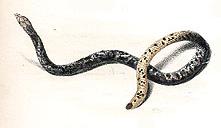
The Indian golden gecko or Beddome's golden gecko is a species of gecko endemic to the Eastern Ghats of India. It was rediscovered from the hills near present-day Tirupati. The rediscovery was after over 100 years since its description.

The Southern Ghats slender gecko is a species of gecko with a restricted distribution in the hills of southern India.

Melanophidium bilineatum, commonly known as the two-lined black shield-tail snake or iridescent shield-tail snake, is a species of snake endemic to India. This species was known from only three specimens and very little information is available of it in the wild.

Melanophidium wynaudense, commonly known as the Indian black earth snake, is a species of snake in the family Uropeltidae. The species is endemic to India.
Platyplectrurus trilineatus, commonly known as the tri-striped shield-tail snake or the lined thorntail snake, is a species of uropeltid snake endemic to the Western Ghats of Southern India. Like most other shieldtail snakes, it is presumed to be a nocturnal, fossorial snake inhabiting evergreen forests. A very rare snake, about which nothing is known in terms of live colouration and natural history.
The Karnataka burrowing snake is a species of uropeltid snake endemic to India.

Plectrurus guentheri, commonly known as Günther's burrowing snake, is a species of snake in the family Uropeltidae. The species is endemic to the Western Ghats of India.

Rhinophis sanguineus, commonly known as the salty earth snake, is a species of uropeltid snake found in the Western Ghats of India.
The purple-red earth snake is a species of nonvenomous shield tail snake, endemic to southern India. No subspecies are currently recognized.
Uropeltis broughami, commonly known as Brougham's earth snake or the Sirumalai shieldtail, is a species of snake in the family Uropeltidae. The species is endemic to the Western Ghats in southern India.
Uropeltis ceylanica is a species of nonvenomous shieldtail snake in the family Uropeltidae. The species is endemic to the Western Ghats of South India. No subspecies are currently recognized as being valid, but the presence of several synonyms, many recently resurrected, calls for further taxonomic studies of this species complex. It is a burrowing snake with a pointy head equipped to penetrate the soil. It has a thick tail which looks as if it has been cut at an angle. In Kerala it's called iru thala moori, which means two headed organism, as the tail end looks like another head. It primarily eats earth worms.
Uropeltis dindigalensis, commonly known as the Dindigul uropeltis and the Sirumalai Hills earth snake, is a species of snake in the family Uropeltidae. The species is endemic to Sirumalai and surrounding hill ranges of the southern Eastern Ghats, in Dindigul district of Tamil Nadu state in South India.

Uropeltis maculata, also known commonly as the spotted earth snake and the spotted shieldtail, is a species of nonvenomous snake in the family Uropeltidae. The species is endemic to southern India. There are no subspecies that are recognized as being valid.
Uropeltis nitida is a species of nonvenomous shieldtail snake. The species is endemic to southern India. There are no subspecies that are recognized as being valid.
Uropeltis ocellata is a species of non-venomous shieldtail snake in the family Uropeltidae. The species is indigenous to southern India. There are no subspecies that are recognized as being valid.

Uropeltis phipsonii, commonly known as Phipson's earth snake and Phipson's shieldtail, is a species of snake in the family Uropeltidae. The species is endemic to India.

Uropeltis pulneyensis, commonly known as the Indian earth snake and the Palni shieldtail, is a species of snake in the family Uropeltidae. The species is endemic to the Western Ghats of India.

Uropeltis rubromaculata is a species of nonvenomous shieldtail snake in the family Uropeltidae. The species is endemic to southern India. There are no subspecies that are recognized as being valid.
Smith's earth snake, also known commonly as the violet shieldtail, is a species of nonvenomous snake in the family Uropeltidae. The species is endemic to India.

Uropeltis shorttii, also known commonly as the Shevaroy Hills earth snake and Shortt's shieldtail snake, is a species of non-venomous snake in the family Uropeltidae. The species is endemic to the southern Eastern Ghats of India. This species was first described as Silybura shorttii by British naturalist Richard Henry Beddome in 1863. It is found only in the Shevaroy Hills of Salem district in Tamil Nadu state in South India. For a long time, this species was misclassified into Uropeltis ceylanica, a snake endemic to the Western Ghats, till a recent taxonomic study proved it to be a distinct species with a very narrow geographic range. It is a burrowing snake, presumed to be nocturnal, feeding on soft-bodied worms. It becomes active during the rains. U. shorttii has most recently been assessed for The IUCN Red List of Threatened Species in 2019, and is listed as "Critically Endangered" under criteria B1ab(iii).












